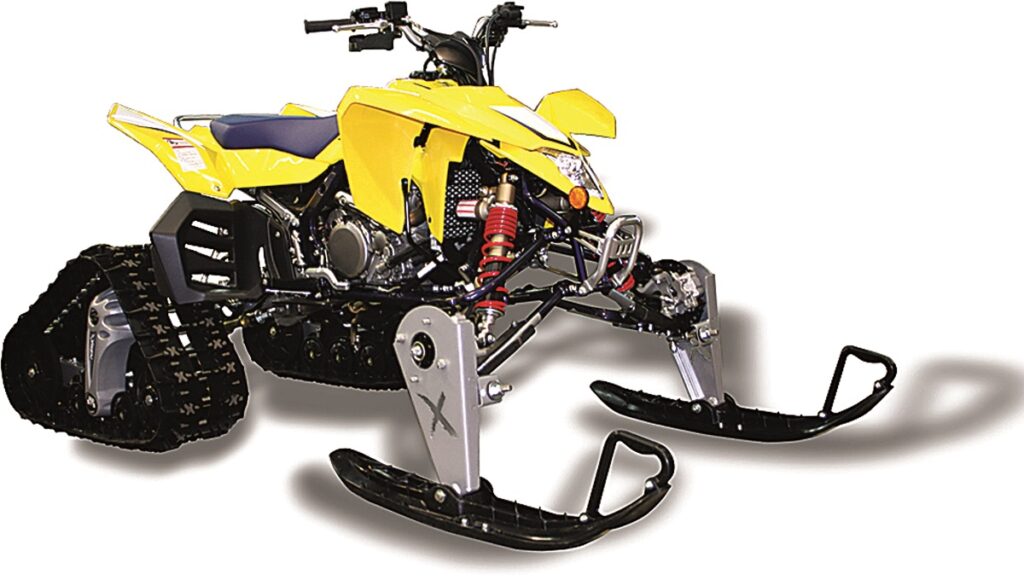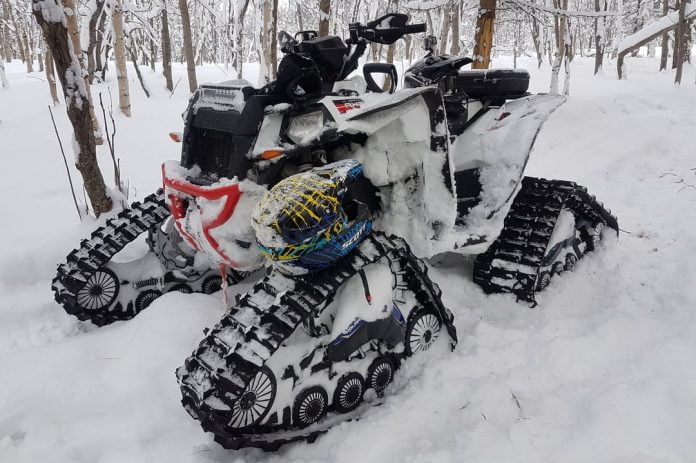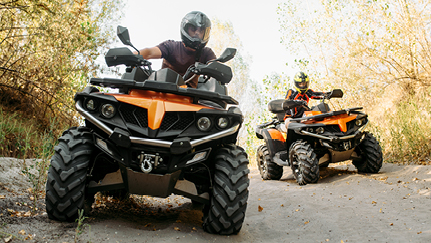All-terrain vehicles are popular off-road vehicles used for recreational activities and work purposes.
here are many different types of ATVs, but they all have one thing in common, the ability to handle rough terrain.
One of the main differences between various types of ATVs is the length of their front and rear tracks.
In general, front-track ATVs are longer than rear-track ATVs. But why is this the case?
Front-track ATVs are longer than rear-track ATVs because they require more stability and a wider support base to navigate uneven terrain and maintain balance during turns.
The longer front track helps distribute the weight of the vehicle and its rider more evenly, reducing the risk of tipping over.
In this article, we will explore the reasons behind this difference in track length and how it affects the performance of ATVs in various environments.
What Are Front Track ATVs?
Front-track ATVs are designed with a single, wide front track and a narrow rear track.
The single track at the front provides improved steering control and stability, especially when navigating rough terrain.
Front-track ATVs are commonly used for racing, high-speed riding, and exploring uneven terrain.
What Are Rear Track ATVs?

Rear-track ATVs are designed with two parallel tracks at the rear and a single track at the front.
The dual tracks at the rear provide increased traction and stability, which makes them ideal for hauling heavy loads and navigating through deep snow or mud.
Rear-track ATVs are commonly used for farming and other outdoor work, as well as for hunting and other recreational activities.
Why Are Front Track ATVs Longer Than Rear Track ATVs?
There are several reasons why front-track ATVs are typically longer than rear-track ATVs. Let’s have a closer look at some of these reasons:
1. Stability
One of the main reasons why front-track ATVs are longer is because they require additional length for increased stability.
With a single, wide front track, these ATVs need more space between the front and rear wheels to maintain balance and prevent tipping.
The additional length helps distribute the weight of the ATV more evenly, improving stability and reducing the risk of accidents.
2. Steering Control

Another reason why front-track ATVs are longer is that they require additional space for improved steering control.
With a single track at the front, these ATVs need more room to maneuver and turn.
The additional length gives the driver more space to control the steering and make tight turns, which can be especially important when navigating through narrow or winding trails.
3. Riding Comfort
Front-track ATVs are typically designed for high-speed riding and racing.
As a result, they require additional length to provide a comfortable ride.
The longer wheelbase helps absorb shocks and vibrations, reducing rider fatigue and discomfort.
It is especially important when riding on rough terrain, where a bumpy ride can quickly become uncomfortable and exhausting.
4. Maneuverability
While front-track ATVs require more length for improved stability and steering control, rear-track ATVs require less for improved maneuverability.
With two tracks at the rear, these ATVs can pivot more easily and make tighter turns. It makes them ideal for navigating through tight spaces and narrow trails.
5. Traction
Rear-track ATVs are designed to provide increased traction, especially in deep snow or mud.
With two tracks at the rear, these ATVs can distribute the vehicle’s weight more evenly, improving traction and preventing slipping.
It can be especially important when hauling heavy loads or navigating difficult terrain.
Difference Between Front Track ATVs And Rear Track ATVs

Front-track and rear-track all-terrain vehicles (ATVs) have some significant differences that set them apart from each other.
These differences include design, functionality, performance, and intended use.
This article will explore the main differences between front-track and rear-track ATVs.
1. Design
The design of a front-track ATV differs from a rear-track ATV. Front-track ATVs feature a single, wide front and a narrow track at the back.
On the other hand, rear-track ATVs have two parallel tracks at the rear, with a single track at the front.
2. Functionality
Front-track ATVs are designed for speed and racing. They provide improved stability and steering control, especially when navigating rough terrain.
They’re also suitable for exploring uneven terrain, including dunes and rocky terrain.
On the other hand, rear-track ATVs are designed for carrying heavy loads and navigating through deep snow and muddy terrains.
They offer increased traction and stability, making them ideal for off-road work, hunting, and other recreational activities.
3. Performance
The performance of front-track and rear-track ATVs differs due to their distinct designs.
Front-track ATVs are faster than rear-track ATVs and provide excellent maneuverability.
They’re also less bulky and lower weight, ideal for racing and high-speed riding.
On the other hand, rear-track ATVs are slower than front-track ATVs, but they offer increased stability and traction, making them ideal for off-road work.
4. Intended Use

Another significant difference is the intended use of front-track and rear-track ATVs.
Front-track ATVs are designed for speed, high-speed riding, and racing, and they’re suitable for riders who want thrilling and fast-paced rides.
They’re also ideal for recreational riders who love exploring challenging terrains like dunes, rock gardens, and other rough terrains.
Rear-track ATVs, on the other hand, are designed for off-road work, hauling heavy loads, hunting, and other outdoor activities that require a vehicle with superior traction, stability, and durability.
5. Terrain
Another significant difference between front-track and rear-track ATVs is the terrain they can operate effectively.
Front-track ATVs are suitable for relatively flat or sloping terrains. They can also easily handle challenging terrains, including rocks, sand, and gravel.
Rear-track ATVs, conversely, are designed for uneven terrains, such as deep snow and muddy areas.
Their superior traction and stability can traverse these terrains more effectively.
6. Cost
Front-track and rear-track ATVs also differ in terms of cost. Front-track ATVs are generally less expensive than rear-track ATVs.
The former requires less material and manufacturing processes, making them less costly.
On the other hand, rear-track ATVs are more expensive because they require more material and complex manufacturing processes.
Conclusion
The length of the front and rear tracks on an ATV plays a crucial role in its performance and capabilities.
Front-track ATVs are longer than rear-track ATVs because they need stability and better weight distribution.
It is especially important when riding over rough, uneven terrain.
The longer front track allows the ATV to handle obstacles with more precision and control, while the shorter rear track provides better maneuverability and agility.
Ultimately, the choice between a front-track and a rear-track ATV depends on the vehicle’s intended use and the rider’s preferences.
Frequently Asked Questions
1. What Is The Purpose Of The Longer Front Track On ATVs?
The longer front track on ATVs is designed to provide stability and balance while riding on uneven terrain. It helps distribute the weight of the vehicle and rider more evenly, reducing the risk of tipping over.
2. Can I Use A Rear-track ATV For The Same Activities As A Front-track ATV?
Rear-track ATVs are better suited for hauling heavy loads or working in deep snow, but they may not provide the same level of stability and control as front-track ATVs when navigating rough terrain or sharp turns.
3. Do Front-Track ATVs Have Better Traction Than Rear-track ATVs?
Both front and rear-track ATVs can have good traction depending on their design and the terrain conditions. However, front-track ATVs may have an advantage regarding stability and balance, which can help improve overall traction.
4. Can I Ride A Front-track ATV On Pavement Or Concrete?
Front-track ATVs are designed for off-road use and may not perform as well on paved surfaces due to their specialized suspension and tire design. Additionally, riding an ATV on public roads in certain areas may not be legal.
5. Are Front-Track ATVs Safer Than Rear-track ATVs?
Front-track ATVs can provide better stability and balance in certain situations, but no ATV is completely safe. It’s important to wear proper safety gear and follow all recommended guidelines and precautions when operating ATVs.
Related Articles
- 2021 Axis 500 Noise When Coasting Downhill – Safe Your Ride In 2023
- All Know About Stock Baffle Removal Of ATV – Complete Guide
- Are 400 Hours A lot For Atv? | 5 Factors In Detailed 2023
- Are Japanese ATV Brands Better Than Chinese?
- ATV Accelerating Without Giving It Gas – Facts One Must Know In 2023!
